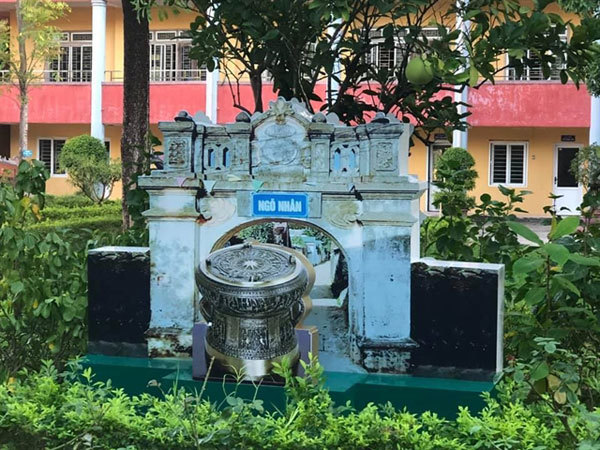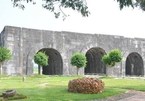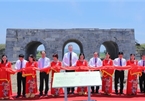 |
| A corner of the complex in the Tran Mai Ninh Secondary School. VNA Photos Khieu Tu |
Autumn sunlight is spread out over the replica complex in the schoolyard inspiring students to learn a new subject -- location education.
Some of the 15 replicas such as the Ho Dynasty Citadel, the Ham Rong Bridge, Ba Dinh Square and others are set in a 2,000 square metre yard in the school. The complex was completed two months ago to meet the demands of teaching the new subject for the 2021-22 school year.
 |
| CARBON COPY: A replica of the citadel of the Ho Dynasty (1400-1407). The citadel was recognised as a World Culture Heritage site by UNESCO in 2011. |
The complex was built during the summer vacation with a view to serving Grade 6 students under the Ministry of Training and Education's instruction and the provincial Department of Training and Education's curriculum, according to Tran Thi Phuong Lan, principal of the school.
"The replicas aim to help students see historic relic sites and landscapes of the province at the school who have not had a chance of going to the real sites due to the COVID-19 pandemic," Lan said.
"It also makes teaching and learning more effective and noteworthy, inspiring students in patriotism and national pride. The students will be aware of the tradition of preservation and development. Field trips cannot be held due to the pandemic, so the replicas are really helpful for teaching and learning."
The highlights of the site are the replica of Ba Dinh Square and the statue of President Ho Chi Minh reading the Declaration of Independence to establish the Democratic Republic of Vietnam in 1945.
It is a nice surprise for students who mostly have not had a chance to visit Ba Dinh Square in Hanoi. They possibly do not know that the square was named after the historic Ba Dinh Uprising in Nga Son District in Thanh Hoa Province in the 19th century.
Each replica in the complex is accompanied by an information board.
Near the gate of the school is the replica of the relic of the citadel of the Ho Dynasty (1400-1407), which was recognised as a World Culture Heritage site by UNESCO in 2011.
The citadel, mentioned in Đại Việt Sử Ký Toàn Thư (The Complete Annals of the Great Việt), was built during the reign of King Tran Thuan Tong (1388-98) by Prime Minister Ho Quy Ly, who acceded to the throne in 1400.
It is the only fortified citadel with unique stone architecture remaining in Southeast Asia.
Another replica, Ngo Nhan (Nhan Lane), was selected among five lanes, namely Nhan, Nghia, Tri, Le and Dung, representing the five constant virtues of kindness, uprightness, wisdom, decorum and braveness, in a Dong Son ancient village to be placed at the site.
 |
| GATE OF LEARNING: Ngo Nhan (Nhan Hamlet) was selected among five hamlets to be placed in the complex. |
It is the only original lane gate remaining in the village, according to the principal.
A replica of a Dong Son bronze drum is placed together with Ngo Nhan to let the students know more about Dong Son culture. Dong Son District was the first place to unearth ancient Dong Son bronze drums dating back to more than 2,000 years ago.
Selecting the historical sites and landscapes symbolising the province development was discussed by the teachers, according to Lan.
"We want the students to have a comprehensive view not only of history and culture but also society and economy," she said.
This explains why the complex also comprises of the Nghi Son Economic Zone, Sam Son Beach and Pu Luong Natural Reserve.
"The complex is beautiful and useful for us," said Truong Gia Bao, a pupil from Class 6H. "It encourages me to learn about the popular historical relic and geographic sites in Thanh Hoa Province."
Tran Huu Phuoc from Class 6B also expressed his interest in the site.
"This is a wonderful model helping us know more about the historical sites and landscapes of my homeland in an effective way," he said.
According to Le Ha Nhat Lam, from Class 6A, the complex inspires her and her classmates to learn the new subject in their first year of secondary school.
"It is amazing to see the vivid replicas at the school," Lam said.
"We do not have to sit boringly in the class reading books and watching a projector. We can go to the complex to see the replicas which help us learn about culture, history, geography, society and the economic development of our province."
The complex was completed at the end of August, aimed at welcoming in the new school year. In a short time, it has been effective for both teaching and learning, according to literature teacher Nguyen Thi Loan.
"The students who are lacking knowledge of local history will get to know milestones of the provincial history," Loan said.
"They will be active to learn and be more proud of their homeland and other cultural values of the nation. I assigned the students a task to research and collect information about the relic sites to summarise both in Vietnamese and English. These presentations will also boost the English learning and presentation skills of the students."
A large mural on the wall opposite the site gives historic development and geographic milestones helping not only students but school visitors understand the project.
The site construction won the second prize at the provincial 2021 Science and Technology Innovation Awards. It is one of the nominations for the National Awards, which will announce the winners in December.
Source: Vietnam News

New artifacts unearthed at Ho Dynasty Citadel
New documents that help in understanding the architecture of the Ho Dynasty Citadel in the north-central province of Thanh Hoa were unearthed during a recent excavation.

US-funded conservation project of Ho Dynasty Citadel completed
A ceremony to announce the completion of the restoration project of the southern gate of the Ho Dynasty Citadel in the north-central province of Thanh Hoa took place at the World Cultural Heritage site on June 29.